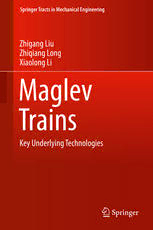
Maglev Trains: Key Underlying Technologies PDF
Preview Maglev Trains: Key Underlying Technologies
Springer Tracts in Mechanical Engineering Zhigang Liu Zhiqiang Long Xiaolong Li Maglev Trains Key Underlying Technologies Springer Tracts in Mechanical Engineering Boardofeditors Seung-BokChoi,InhaUniversity,Incheon,SouthKorea Haibin Duan, Beijing University of Aeronautics and Astronautics, Beijing, P.R.China YiliFu,HarbinInstituteofTechnology,Harbin,P.R.China Jian-QiaoSun,UniversityofCalifornia,Merced,U.S.A AboutthisSeries Springer Tracts in Mechanical Engineering (STME) publishes the latest develop- mentsinMechanicalEngineering–quickly,informallyandwithhighquality.The intentistocoverallthemainbranchesofmechanicalengineering,boththeoretical andapplied,including: (cid:129) EngineeringDesign (cid:129) MachineryandMachineElements (cid:129) Mechanicalstructuresandstressanalysis (cid:129) AutomotiveEngineering (cid:129) EngineTechnology (cid:129) AerospaceTechnologyandAstronautics (cid:129) NanotechnologyandMicroengineering (cid:129) Control,Robotics,Mechatronics (cid:129) MEMS (cid:129) TheoreticalandAppliedMechanics (cid:129) DynamicalSystems,Control (cid:129) Fluidsmechanics (cid:129) EngineeringThermodynamics,HeatandMassTransfer (cid:129) Manufacturing (cid:129) Precisionengineering,Instrumentation,Measurement (cid:129) MaterialsEngineering (cid:129) Tribologyandsurfacetechnology Within the scopes of the series are monographs, professional books or graduate textbooks,editedvolumesaswellasoutstandingPhDthesesandbookspurposely devoted to support education in mechanical engineering at graduate and post- graduatelevels. Moreinformationaboutthisseriesathttp://www.springer.com/series/11693 Zhigang Liu (cid:129) Zhiqiang Long (cid:129) Xiaolong Li Maglev Trains Key Underlying Technologies 123 ZhigangLiu ZhiqiangLong SouthwestJiaotongUniversity NationalUniversityofDefenseTechnology Chengdu,China Changsha,China XiaolongLi NationalUniversityofDefenseTechnology Changsha,China ISSN2195-9862 ISSN2195-9870 (electronic) SpringerTractsinMechanicalEngineering ISBN978-3-662-45672-9 ISBN978-3-662-45673-6 (eBook) DOI10.1007/978-3-662-45673-6 LibraryofCongressControlNumber:2015937390 SpringerHeidelbergNewYorkDordrechtLondon ©Springer-VerlagBerlinHeidelberg2015 Thisworkissubjecttocopyright.AllrightsarereservedbythePublisher,whetherthewholeorpartof thematerialisconcerned,specificallytherightsoftranslation,reprinting,reuseofillustrations,recitation, broadcasting,reproductiononmicrofilmsorinanyotherphysicalway,andtransmissionorinformation storageandretrieval,electronicadaptation,computersoftware,orbysimilarordissimilarmethodology nowknownorhereafterdeveloped. Theuseofgeneraldescriptivenames,registerednames,trademarks,servicemarks,etc.inthispublication doesnotimply,evenintheabsenceofaspecificstatement,thatsuchnamesareexemptfromtherelevant protectivelawsandregulationsandthereforefreeforgeneraluse. Thepublisher,theauthorsandtheeditorsaresafetoassumethattheadviceandinformationinthisbook arebelievedtobetrueandaccurateatthedateofpublication.Neitherthepublishernortheauthorsor theeditorsgiveawarranty,expressorimplied,withrespecttothematerialcontainedhereinorforany errorsoromissionsthatmayhavebeenmade. Printedonacid-freepaper Springer-VerlagGmbHBerlinHeidelbergispartofSpringerScience+Business Media(www.springer. com) Preface Maglev (derived from magnetic levitation) is a system of transportation that sus- pends,guidesandpropelsvehicles,predominantlytrains,usingmagneticlevitation from a very large number of magnets for lift and propulsion. In terms of the magnetismbetweenmagnetsandmagneticcomponentsonthetrack,Maglevtrain is attractedto suspendabovethe track.The traveloftrain dependson the traction of linear motors in the vehicle. In order to ensure the safe operation of Maglev train, some key technologies must be adopted and realized, such as suspension and orientation technology,safe braking technology,position and speed detection technology, control and diagnosis technology. In the book, we present them and provide corresponding new technologies or ideas on control and diagnosis of Maglev train. We hope the contentsof the book can providesome referencesand helps for the researcher, scholar, engineer on Rail Transit industry and Maglev technology. Thebookcomprisessixchapters,coveringabout200pages.Thesechapterswere writtenbyZhigangLiu,ZhiqiangLongandXiaolongLifromSouthwestJiaotong UniversityandNationalUniversityofDefenseTechnologyinChina. The book begins with an introduction of Maglev train. In Chap. 1, the char- acteristics and classification of Maglev train are presented. Some research and major achievementsof Maglev train key technologiesare discussed in detail. The technologycharacteristicsofhigh-speedMaglevtrainandlow-speedMaglevtrain are presented. Specially, the technology characteristics of TR08 Maglev train are discussed,andtheoveralldesignideaofTRMaglevtrainisoutlined.InChap.2,the technologydevelopmentandapplicationresearchofMaglevcontrolarediscussed andsummarized,mainlyincludingsuspensioncontrolplanandsuspensioncontrol algorithmsofMaglevtrain.Chapter3discussesthemodelingandcontrollerdesign of suspension system of Maglev train in detail. They mainly include building single point suspension model, design of control system, optimization of control parameters under the condition of output saturation, design of signal filter of suspension control system and experimental research. Chapter 4 discusses the control and diagnosis system of Maglev train, which mainly includes on-board control and diagnosis system, comprehensive assessment algorithm of on-board v vi Preface faults based on fuzzy comprehensive assessment, and comprehensive assessment method based on EDA (estimation of distribution algorithm). In Chap. 5, the on- boardcontrolanddiagnosisnetworksofMaglevtrainareintroduced.Maincontents include the communication simulation of on-board diagnosis network, integrated networkdesignofthecontrolanddiagnosisnetworks,diagnosisnetworkbasedon ADS,controlanddiagnosisnetworksbasedonroleautomationdecentralization,and on-boardcommunicationplatforminMaglevtrainbasedonRTLinux.InChap.6, the position and speed detection technology based on loop-cable for low-speed Maglevtrainis introducedanddiscussed indetail. Maincontentsincludeposition andspeeddetectionbasedontheXORpulse,positionandspeeddetectionbasedon sampling,andexperimentsandsystemimplementation. One important feature of the book is that some new technologies or ideas on controlanddiagnosisofMaglevtrainareproposedanddiscussed.Theexperiments presentedarereal-lifeengineeringproblems,aswellasproblemsthatcanbehelpful toapplynewtechniquesinMaglevtrain. ThestudiesreportedinthisbookclearlyindicateanincreasinginterestinMaglev traincontrolanddiagnosistechnologiesforreal-lifeengineeringapplications.These studiesare expectedto simulate the interestof otherresearchersaroundthe world whoarefacingnewchallengesinMaglevtrainandkeytechnologies. Chengdu,China ZhigangLiu Changsha,China ZhiqiangLong Changsha,China XiaolongLi Acknowledgments The authors would like to thank master degree candidates Ke Huang and Song GaoanddoctordegreecandidatesFengshanDou,ChunhuiDai,SongXue,Dapeng Zhang,NingHe,LianchunWangandHehongZhangfortheirhelpinproofreading. TheyalsowishtothankEngineersLuoLiandQiHongfengforprovidingreference materials. vii Contents 1 MaglevTrainOverview ..................................................... 1 1.1 Introduction ............................................................. 1 1.2 CharacteristicsandClassificationofMaglevTrain.................... 2 1.3 ResearchandMajorAchievementsintheWorld...................... 5 1.4 ResearchandMajorAchievementsinChina .......................... 7 1.5 DevelopmentandDiscussionofMaglevKeyTechnologies.......... 9 1.5.1 Low-SpeedMaglevTrains ..................................... 9 1.5.2 High-SpeedMaglevTrains..................................... 11 1.6 TechnologyCharacteristicsofHigh-SpeedMaglevTrain ............ 13 1.6.1 TechnologyCharacteristics..................................... 13 1.6.2 SuspensionandGuidanceSystem ............................. 14 1.6.3 LongStatorSynchronousLinearMotorTraction............. 14 1.6.4 Braking.......................................................... 15 1.6.5 Vehicle–RailRelationship...................................... 16 1.6.6 PowerSupplyforOnboardDevices ........................... 17 1.6.7 PositioningandMobileCommunication ...................... 17 1.6.8 OverallDesignIdeasofTRHigh-SpeedMaglevTrain....... 18 1.7 TechnologyCharacteristicsofLow-SpeedMaglevTrain............. 20 1.7.1 SuspensionandGuidanceFunctionRealization ofLow-SpeedMaglevTrain ................................... 21 1.7.2 TractionFunctionRealizationofHSSTMaglevTrain........ 21 1.7.3 BogieStructureofHSSTMaglevTrain ....................... 23 1.7.4 TechnologyCharacteristics..................................... 23 1.8 Conclusion .............................................................. 24 References..................................................................... 26 2 Technology Development and Application Research ofMaglevControl............................................................ 29 2.1 Introduction ............................................................. 29 2.2 SuspensionControlPlanofMaglevTrain............................. 30 2.2.1 SingleElectromagnetSuspensionControlScheme........... 31 ix
